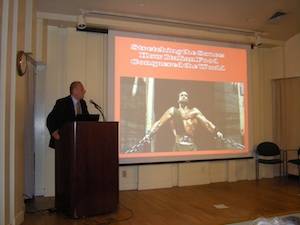How Italian Food Conquered... Casa Italiana
No matter how much we all take it for granted, it is always impressive to see how strongly Americans feel the pull of Italian cuisine.
On March 21, finding an empty seat in the auditorium of Casa Italiana was virtually impossible. We couldn’t help but marvel at so much interest, even though it was well justified by the array of panelists who spoke at the conference: John Mariani, Marco Maccioni and Tony May.
John Mariani, famous food critic and writer, was there to present his latest book “How Italian Food Conquered the World”. The volume explains how what originally was a poor, regional cuisine became the most appreciated and influential gastronomy in the world.
During his speech, he focused on the New York gourmet scene and explained how Italian restaurants became the undisputed stars of this system.
Mariani started off with a few historical notes that gave the public an idea of how some of the most common ingredients of Italian cuisine arrived to Italy: Marco Polo brought back rice from China, Columbus (who set out on his quest looking for spices, making his journey technically a food trip) imported corn, tomato, chili and potatoes.
After a few centuries of experimenting with these new ingredients, Italian cuisine was ready to be exported back to America with the first wave of Italian immigrants, during the second half of the 19th century.
It took a while, however, for New York to see its first pizzeria: in 1905 Lombardi’s Pizza opened for business, and never closed to this day.
Still, for a good part of the 20th century, Italian food was not considered a world-class cuisine, but rather a greasy and cheap alternative to a hamburger.
This was also due to the social status of Italian immigrants: poor laborers, without much refinement. It is iconic how the true Little Italy of New York today, around Arthur Ave, in the Bronx, came to be. Stonemasons were needed for the construction of the Bronx zoo; Italians answered the call, and never left.
With time, Italians grew in power and social status, but what they became associated with was not culture or good taste; rather something much less worthy of praise, but with a far greater impact on popular culture: mafia.
At this point, in the mid-20th century, Italian restaurants were regarded as dodgy places were you would be sure to see gangsters eating their spaghetti. Not exactly what one would associate with sophistication and glamour, so Italian restaurants still remained relegated to a gastromic subclass of highly debatable reputation.
It is thanks to the fashion system that Italian food became what it is today. In the 1980s, in the center of Milan, there were some restaurants that became daily fixtures for fashion designers from all over the world. Among these joints: Giannino, Bagutta and, last but not least, Bice who has now several restaurants all over the States.
The association of Italian food with the beauty, elegance, sophistication and exclusivity typical of the fashion world, eventually propelled Italian gastronomy to the stratosphere of the food scene.
Mariani’s theories were backed by the personal stories of two of the most successful restaurateurs of New York.
Marco Maccioni is the co-owner, together with his father Sirio and siblings, of “Le Cirque”.
This venue opened in 1974. Back then Italian food was not yet what it is today, and the entrepreneurial ability of Marco’s father prompted him to use a French name for his restaurant, as French cuisine was the most sophisticated cuisine in the world. This anecdote is enough to show the mistrust Americans had toward Italian food.
In spite of the name, Italian cuisine was heavily enforced at Le Cirque, always with special attention to its core value: simplicity; to let the ingredients speak for themselves.
It is thanks to simplicity that one of the most appreciated Italian-American dishes was invented: Marco’s father went for a weekend in Nova Scotia with other couples. The deal was that each day someone would cook for the rest of the group. However, when it was Sirio’s turn he realized he did not have the ingredients to prepare what he had in mind, so he settled for a simple pasta recipe with the few leftover vegetables and condiments. As they say: a star was born.
After Marco, Tony May took the spotlight. Tony is another extremely successful food entrepreneur. Owner of venues such as SD26, San Domenico and Palio, he is one of those who made the history of Italian gastronomy in New York.
He remembered the tough beginnings, confirming that Italy in the kitchen was wildly unappreciated just 40 years ago.
He did not let this stop him, and pushed forward, trying to prove that there is such thing as Italian haut cuisine, even though the press initially did not understand this. Back in the days critics thought that “authenticity [in Italian cuisine] is a high school dropout making salami in a Brooklyn basement.”
I guess we can only say that time proved Tony right.
The last minutes of the conference were dedicated to the public, and the discussion focused on the role of critics today, with mixed opinions. While online reviewing open to everybody was praised for giving the customer voice, it was underlined that there is no assurance that those who review a place know what they are talking about, or even ever went there. Food critics, on the other hand, know what they write about, but often are more concerned about what is hip and new than about what is actually good.
After the conference John Mariani took some time to sign copies of his book, and was kind enough to answer our question: if he thinks that there is any other cuisine that could overthrow this “Italian domination”.
John thinks that due to the amount of South Americans coming to the US, perhaps, in some decades, Mexican food may take Italy’s crown.
Get ready to have tacos instead of pizza during the 2031 Superbowl.






































i-Italy
Facebook
Google+
This work may not be reproduced, in whole or in part, without prior written permission.
Questo lavoro non può essere riprodotto, in tutto o in parte, senza permesso scritto.